Significant battles
Hampton Roads
One of the most important and famous naval battles of the American Civil War was the clash of the ironclads, between USS Monitor and CSS Virginia at the Battle of Hampton Roads. The battle took place on March 8, 1862, and lasted for several hours, resulting in a tactical draw. These revolutionary new warships were protected by the thick armor plating that gives them the name ironclad, which prevented any lasting damage to either ship.
New Orleans
The battle of Forts Jackson and St. Philip in 1862 can be divided into two parts: a mostly-ineffective bombardment of the Confederate-held forts by the raft-mounted mortars, and the successful passage of the forts by much of Farragut's fleet on the night of April 24. During the passage, one Federal warship was lost and three others turned back, while the Confederate gunboats were virtually obliterated. The subsequent capture of the city, achieved with no further significant opposition, was a serious, even fatal, blow from which the Confederacy never recovered.
First Charleston
A second great naval battle occurred at Charleston, South Carolina, in 1863. In this battle, called the First Battle of Charleston Harbor, the Union Navy sent Admiral Du Pont with nine ironclads to attack Charleston. When given the order, the admiral did not expect to be victorious. He would have to steer his ships upriver to the fort and attack it from a standstill, giving the Confederates a valuable edge. The Union Navy was forced to retreat within two hours to prevent too many casualties in a single battle, which would irreparably cripple the navy. Because of this failure, the Union would blockade Charleston for two more years, while the Confederacy was able to set up several more forts along the coast of South Carolina. [1]
Cherbourg
The Battle of Cherbourg was an intense naval battle that ended in the sinking of CSS Alabama, one of the most powerful ships in the Confederate fleet, by USS Kearsarge. Alabama fired the first shot, but Kearsarge was slightly faster, had more firepower, and carried a larger crew complement than Alabama, giving the Union the advantage. The Confederate ship took many hits and casualties, and the rising water shut off its engines, leaving the surviving crew with no other choice but to surrender and be rescued by Kearsarge. [2]
Other purposes
The navies on both sides not only engaged in battle, but also transported foot soldiers, equipment, and supplies. Without a navy, neither army would have had the supplies or manpower necessary to successfully carry out the war. [3]
Thus, one major strategy of the Union navy involved blockading Southern ports, preventing the South from receiving supplies or aid from allies via shipping ports. Vital supplies such as food, water, ammunition, guns, clothes, and medical supplies never made it to the Confederate troops. The Confederates retained a sufficient amount of resources to withstand the blockade for an extended period of time, causing the war to last longer than expected. However, the blockade continued to prevent the Confederate troops from replenishing their supplies, which in part led to their eventual surrender. [4]
Naval ships on both sides also served as much-needed floating hospitals, housing and treating soldiers who had been injured in battle.
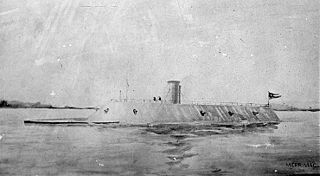
CSS Virginia was the first steam-powered ironclad warship built by the Confederate States Navy during the first year of the American Civil War; she was constructed as a casemate ironclad using the razéed original lower hull and engines of the scuttled steam frigate USS Merrimack. Virginia was one of the participants in the Battle of Hampton Roads, opposing the Union's USS Monitor in March 1862. The battle is chiefly significant in naval history as the first battle between ironclads.

USS Housatonic was a screw sloop-of-war of the United States Navy, gaining its namesake from the Housatonic River of New England.

The Battle of Hampton Roads, also referred to as the Battle of the Monitor and Merrimack or the Battle of Ironclads, was a naval battle during the American Civil War.

The Confederate States Navy (CSN) was the naval branch of the Confederate States Armed Forces, established by an act of the Confederate States Congress on February 21, 1861. It was responsible for Confederate naval operations during the American Civil War against the United States's Union Navy.
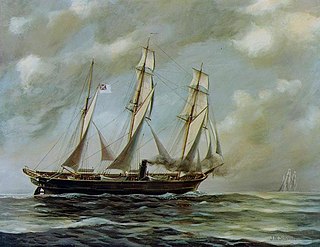
CSS Alabama was a screw sloop-of-war built in 1862 for the Confederate States Navy. It was built in Birkenhead on the River Mersey opposite Liverpool, England by John Laird Sons and Company. Alabama served as a successful commerce raider, attacking Union merchant and naval ships over the course of her two-year career. She was sunk in June 1864 by USS Kearsarge at the Battle of Cherbourg outside the port of Cherbourg, France.

John Lorimer Worden was a U.S. Navy officer in the American Civil War, who took part in the Battle of Hampton Roads, the first-ever engagement between ironclad steamships at Hampton Roads, Virginia, on 9 March 1862.

CSS Tennessee was a casemate ironclad ram built for the Confederate Navy during the American Civil War. She served as the flagship of Admiral Franklin Buchanan, commander of the Mobile Squadron, after her commissioning. She was captured in 1864 by the Union Navy during the Battle of Mobile Bay and then participated in the Union's subsequent Siege of Fort Morgan. Tennessee was decommissioned after the war and sold in 1867 for scrap.
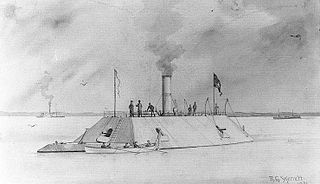
CSS Palmetto State was one of six Richmond class casemate ironclad rams built for the Confederate States Navy during the American Civil War. Completed in 1862, she defended Charleston, South Carolina and was burnt in 1865 to prevent her capture by advancing Union troops.

CSS Chicora was a Confederate ironclad ram that fought in the American Civil War. It was built under contract at Charleston, South Carolina in 1862. James M. Eason built it to John L. Porter's plans, using up most of a $300,000 State appropriation for construction of marine batteries; Eason received a bonus for "skill and promptitude." Its iron shield was 4 inches (102 mm) thick, backed by 22 inches (559 mm) of oak and pine, with 2-inch (51 mm) armor at its ends. Keeled in March, it was commissioned in November, Commander John Randolph Tucker, CSN assuming command.
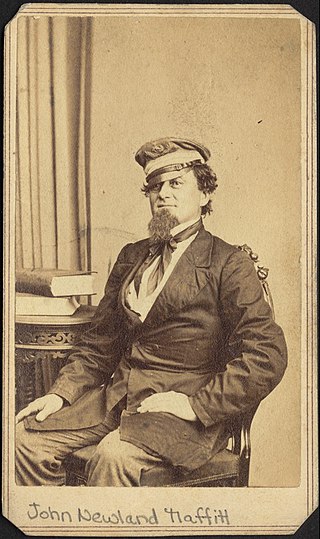
John Newland Maffitt was an officer in the Confederate States Navy who was nicknamed the "Prince of Privateers" due to his success as a blockade runner and commerce raider in the U.S. Civil War.

William Augustin Webb (1824-1881) was an American sailor and Mexican–American War veteran who resigned his United States Navy commission after more than 20 years of service to join the Confederate States Navy in the American Civil War. Webb was decorated for his service as Captain of the CSS Teaser, part of the James River Squadron, during the Battle of Hampton Roads (1862).

CSS Sumter, converted from the 1859-built merchant steamer Habana, was the first steam cruiser of the Confederate States Navy during the American Civil War. She operated as a commerce raider in the Caribbean and in the Atlantic Ocean against Union merchant shipping between July and December 1861, taking eighteen prizes, but was trapped in Gibraltar by Union Navy warships. Decommissioned, she was sold in 1862 to the British office of a Confederate merchant and renamed Gibraltar, successfully running the Union blockade in 1863 and surviving the war.
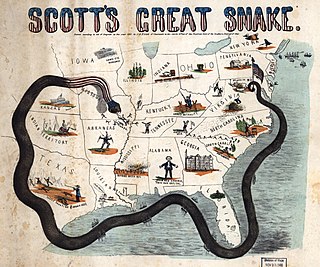
The Union blockade in the American Civil War was a naval strategy by the United States to prevent the Confederacy from trading.

The Battle of Cherbourg, or sometimes the Battle off Cherbourg or the Sinking of CSS Alabama, was a single-ship action fought during the American Civil War between the United States Navy warship, USS Kearsarge, and the Confederate States Navy warship, CSS Alabama, on June 19, 1864, off Cherbourg, France.

The siege of Fort Pulaski concluded with the Battle of Fort Pulaski fought April 10–11, 1862, during the American Civil War. Union forces on Tybee Island and naval operations conducted a 112-day siege, then captured the Confederate-held Fort Pulaski after a 30-hour bombardment. The siege and battle are important for innovative use of rifled guns which made existing coastal defenses obsolete. The Union initiated large-scale amphibious operations under fire.
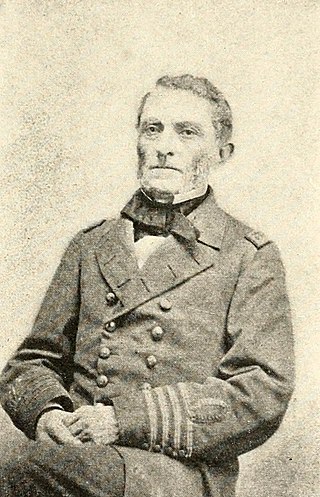
Samuel Barron was a United States, and later Confederate naval officer, acting as a representative in Europe for the Confederacy during the American Civil War.
CSS Louisiana was a casemate ironclad of the Confederate States Navy built to aid in defending the lower Mississippi River from invasion by the Union Navy during the American Civil War. She took part in one major action of the war, the Battle of Forts Jackson and St. Philip, and when that ended disastrously for the Confederacy, she was destroyed by her crew.

During the American Civil War, blockade runners were used to get supplies through the Union blockade of the Confederate States of America that extended some 3,500 miles (5,600 km) along the Atlantic and Gulf of Mexico coastlines and the lower Mississippi River. The Confederacy had little industrial capability and could not indigenously produce the quantity of arms and other supplies needed to fight against the Union. To meet this need, numerous blockade runners were constructed in the British Isles and were used to import the guns, ordnance and other supplies that the Confederacy desperately needed, in exchange for cotton that the British textile industry needed greatly. To penetrate the blockade, these relatively lightweight shallow draft ships, mostly built in British shipyards and specially designed for speed, but not suited for transporting large quantities of cotton, had to cruise undetected, usually at night, through the Union blockade. The typical blockade runners were privately owned vessels often operating with a letter of marque issued by the Confederate government. If spotted, the blockade runners would attempt to outmaneuver or simply outrun any Union Navy warships on blockade patrol, often successfully.
CSS Pamlico was a sidewheel steamer that served in the Confederate States Navy during the early stages of the American Civil War. Originally a passenger vessel on Lake Pontchartrain, she was purchased by Confederate authorities on July 10, 1861, and converted into a gunboat. She participated in two minor naval actions in the vicinities of Horn Island and Ship Island in December, before taking part in two more small battles defending the Pass Christian area in March and April 1862. In late April, Union Navy ships passed the defenses of New Orleans, Louisiana. After ferrying Confederate troops out of the city, Pamlico was burned by her crew on Lake Pontchartrain on April 25 to prevent capture.

















